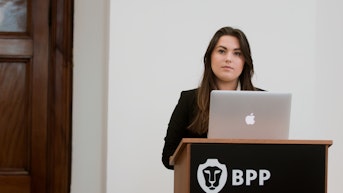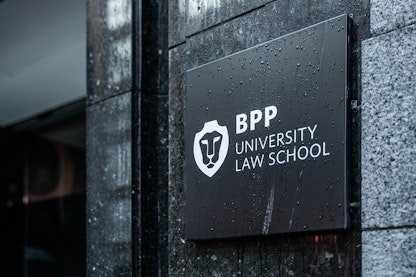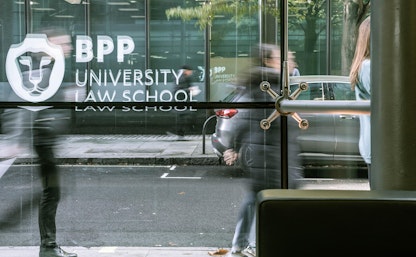Profiling the Law Profession

Lawyers are often a prominent figure in the media and on television. We explore how they're portrayed and whether it's what it's like in the real-world.

From Suits to Law and Order, lawyers are often a prominent figure in the media and on television.
However, conflicting representations on what lawyers look like, can make it hard to know whether what we see on our screens is an accurate portrayal of legal professionals in the industry.
Our team of researchers here at BPP University Law School have collated actor profiles from 30 different legal dramas across the UK and US, to see whether their portrayals of diversity in the legal workplace (or lack thereof) are correct.
Revealed: How is Social Mobility Represented in Legal dramas?
When we looked at social mobility in legal dramas, our research found that there is still work to be done both on and off screen within the legal profession.
On TV, we often see law professionals entering the workforce having graduated from Ivy League and top tier law schools, with parents who support their careers.
For example, in legal drama Suits, law firm Pearson Hardman was known for having a policy in which they only hired associates that had graduated from Harvard Law School, with the rule only changing when Harvey Specter moved into the managing partner role.
Not only that but during the show, Rachel Zane's dad, Robert Zane, is a named partner at the firm, giving her automatic privilege and support towards her career.
In another US legal drama, The Good Wife, Alicia Florrick, the titular character in the show and senior partner, was found to study at GeorgeTown University Law Centre, which is ranked number 14 for the best law schools in the US.
But it's not just American shows that depict a privileged representation of lawyers. In Netflix’s recent limited series Anatomy of a Scandal, Queen’s Counsel Lawyer Kate Woodcroft is revealed to have studied at Oxford University before starting her career in the legal industry.
It's unsurprising that we see this representation of privileged lawyers on TV as it appears to be true of how the legal profession is in reality, despite steps being made towards being more inclusive for those who are less privileged.
In fact data from the SRA revealed that there is evidence of privilege in the legal profession, with only 46% of solicitors working in law firms being state educated.
Legal professionals in the UK are also likely to have parents who are highly educated, with 51% of solicitors' parents having earned a degree.
What Does a Lawyer Look Like According to TV?
One of the most common reasons people don’t pursue a career in law, is because they don’t see anyone in the media who looks similar to them, that acts like them, or comes from the same background.
From analysing characteristics of legal professionals across 30 different legal dramas, we have revealed that the TV industry's perception of a lawyer is still a white, middle-aged male in a senior role, dressed in formal attire like a suit.

Our research revealed that when it came to representation of ethnicity, only 22% of those from a black, or ethnic minority background were cast as main character legal professionals on TV compared to 78% who were white.
Not only that, but looking towards job roles, men were often more likely to be in more senior positions when it came to representation on TV. In fact across the 30 programmes we studied, two thirds (64%) of males were in partner roles compared to 36% of women.
For many legal professionals they are also often expected to dress in formal, professional attire, it makes sense that this is what we see on TV and in the media when it comes to the legal profession, as formal wear demands the kind authority that lawyers need to argue their case.
How are Men and Women Represented in the Legal Profession on TV?

According to data from our 2021 intake, when it came to gender, almost two thirds (64%) of students studying at BPP University Law School were revealed to be women compared to just 36% of men.
However, when analysing lawyers on TV, males appeared to dominate when it came to more seniority. For those in partner or managing partner roles in legal dramas, females made up just over a third (36%), while men made up the rest (64%).
This number is nearly identical to the amount of females in partner roles in the UK which stands at just 35%.
How Ethnically Diverse is the Law Profession in the Media?

When it came to black or ethnic minority representation on TV, our data shone a light on the fact that lawyers in British and American shows were played by white actors and actresses 78% of the time.
Actors and actresses that fell into black or ethnic minority categories were only seen in legal professional roles 22% of the time across the shows that we analysed - but even this paultry number is higher than the 17% of black or ethnic minority lawyers currently in the UK.
Broken down, these stats revealed that only 15% of on-screen lawyers were Black, 1% were Asian, 2% were Middle Eastern and 4% were mixed-race.
While representation of black and ethnic minorities in main character legal roles is making a step in the right direction, these figures show how far writers and directors still need to go to be more representative with their casting.
However, in reality, these statistics are beginning to show signs of improvement. The data collated by the SRA every two years depicted that 16% of senior lawyers and partners were Asian, while 2% of legal partners were Black. 2% were made up of mixed-race individuals, as well as a further 1% of partners being made up of different ethnic groups.
The Top 10 Most Ethnically Diverse Legal Dramas Revealed!
Thankfully, there are some legal dramas that work to be as representative of different cultures and ethnicities as possible.

Taking a seed list of legal dramas that included two legal professionals or more, we used data from All Famous Birthdays, NNDB and more, to determine how ethnically diverse the main characters in legal dramas across the US and UK actually are.
The shows paving the way for black and ethnic minority representation included ‘The Good Fight’, a US-based legal drama, and spin off to ‘The Good Wife’.
As it was first on the list, this programme showcased 50% of its main character legal professionals to be from black or ethnic minority backgrounds.
Next up was ‘For the People’ another us-based TV show, which came in joint first place with ‘The Good Fight’, and scored 50% when it came to diversity. The show stars Jasmin Savoy Brown, Regé-Jean Page and Vondie Curtis-Hall, among others, who are from black or ethnic minority backgrounds, and follows the lawyers as they handle some of the most high-profile cases in the country.
Thirdly, there was US-based ‘Suits’, scoring 37%. Despite the main protagonist being a white male, over its eight-year run, three of its main characters, including Alex Williams, Jessica Pearson and Rachel Zane were all from black or ethnic minority backgrounds, with two of those in partner roles.
Trailing in last place was UK-based ‘The Split’, scoring a disappointing 20% overall. Despite having a cast that included black and ethnic minority actors and actresses, the comparison to the number of white characters in senior legal positions was obvious.
What Does the Law Profession Actually Look Like Right Now?

Luckily, there are schools and universities that are working tirelessly to promote diversity and shake off the TV legal drama stereotype of lawyers being white, middle-aged and male.
At BPP, we are a law school that is committed to diversity and inclusion, with nearly half (41%) of our students from our 2020-2021 cohort identifying as black, Asian or ethnic minority. While we still have a long way to go, this is proof that the gap between ethnic groups in the legal industry is closing, and more needs to be done about how misrepresentative legal TV shows can be.
As well as this, almost two thirds (64%) of our students are female compared to 36% who are male. However, with our research pinpointing the fact that 51% of lawyers in the legal dramas we analysed were males in senior roles, it leads us to wonder how current television writers keep casting their shows so inaccurately.
Overall, our research has highlighted that the TV industry and the media still misrepresent the current legal landscape, allowing the typical image of a lawyer to stay at the front of people's mind.
In reality, while there is still much to be done in the legal profession as a whole, steps are being taken to ensure that those from different backgrounds and social classes have as much opportunity to succeed as others.
Jo-Anne Pugh Dean at BPP University Law School said: “Traditionally the legal industry has been elitist, meaning that only those who are the most advantaged have been more likely to advance towards being a solicitor or barrister, while those in black, ethnic minority groups or non-traditional groups have sometimes not realised the opportunity.
“At BPP University Law School, it is hugely important to us that students from different backgrounds and cultures feel welcomed and offered access to new routes into the profession, including legal apprenticeships and the SQE. Not only that, but our partnerships with the likes of Aspiring Solicitors and The O Shaped Lawyer creates a unique opportunity for us to collectively shine the spotlight on diversity, and put in place schemes, scholarships, and initiatives to break down barriers to the legal profession from a wide range of backgrounds.
“We have a long-term partnership with Aspiring Solicitors, which provides students from non-traditional and low-income backgrounds with support to enter the legal profession, including mentoring, coaching and opportunities at leading organisations and law firms.
“It’s clear from our research that representation of lawyers in both TV and the media still has a long way to go in order to change the image of ‘what a lawyer looks like’ in reality.
“The legal sector is a diverse and innovative place, and it’s important that we recruit students from a representative cross section of society on to our courses to progress into legal roles. It is important that we all work together to help change this perception going forward whether that be representation on TV or providing equal opportunities for those from different backgrounds, so they have the chance to succeed.”
Methodology
Taking a seed list of main character legal professionals, across 30 different legal dramas in the UK and US, BPP has revealed what a lawyer looks like according to the media. The study has also analysed which legal dramas are leading the way with their diversity, what the legal landscape looks like in reality and what more needs to be done.
What does a lawyer look like?
Taking a seed list of 30 different legal dramas across a number of different sources including, ScreenRant, Ranker, IMDb, BBC, Collider, FamousFix and more we revealed what a lawyer looks like according to the media by analysing the following factors:
The characters listed under “main characters” on each TV show on Wikipedia
Their job role and who they were played by from WikiFandom*
The age of the actor when they started their role from Wikipedia
Each actors nationality, ethnicity and sex listed on All Famous Birthdays and NNDB
Once this data was gathered we then calculated what percentage of all of the characters on the list fit into different categories including age, sex and ethnicity.
To determine what clothes lawyers are likely to wear when portrayed in the media, we took a seed list of six different law jobs from Cosmopolitan. We then took the first five images for each profession on Google Images, ran them through Google’s Vision AI Tool and picked out the ‘labels’ that referred to what the people in the image were wearing.
Top TV Shows with Most Ethnically Diverse Legal Professionals
To work out which shows were the most ethnically diverse when it came to legal professionals on TV, we again took our seed list of characters and TV shows. We then calculated what percentage of characters, in shows that had more than two legal professionals as main characters, fit into black and ethnic minority groups in comparison to white and ranked them.
What does the law industry look like now?
To get a picture of what the law landscape actually looks like for those wishing to start their law school journey, we took data from BPP’s 2021 intake and calculated what percentage of students came from different backgrounds.
*If the main characters did not have a job in the legal profession they were removed from the list.

